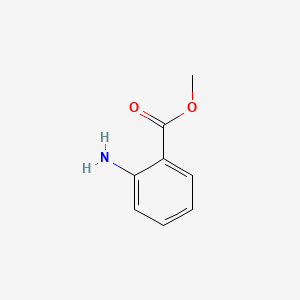


1. Methyl 2-aminobenzoate
2. 134-20-3
3. 2-aminobenzoic Acid Methyl Ester
4. Nevoli Oil
5. Methyl O-aminobenzoate
6. Methylanthranilate
7. Anthranilic Acid Methyl Ester
8. O-carbomethoxyaniline
9. 2-carbomethoxyaniline
10. 2-(methoxycarbonyl)aniline
11. Benzoic Acid, 2-amino-, Methyl Ester
12. Neroli Oil, Artifical
13. Neroli Oil, Artificial
14. Anthranilic Acid, Methyl Ester
15. O-methyl Anthranilate
16. Fema No. 2682
17. O-aminobenzoic Acid Methyl Ester
18. Methyl Antranilate
19. Benzoic Acid, Amino-, Methyl Ester
20. Nsc 3109
21. Methylester Kyseliny Anthranilove
22. O-amino Methyl Benzoate
23. Mfcd00007710
24. 2-aminobenzoic Acid-methyl Ester
25. Chebi:73244
26. O-aminobenzoic Acid, Methyl Ester
27. 2-amino-benzoic Acid Methyl Ester
28. 981i0c1e5w
29. Methyl Ester Of O-aminobenzoic Acid
30. Nsc-3109
31. Methyl 2-aminobenzoate (methyl Anthranilate)
32. Dsstox_cid_5567
33. Dsstox_rid_77832
34. Dsstox_gsid_25567
35. Amino Methyl Benzoate, O-
36. Cas-134-20-3
37. Methyl Anthranilate (natural)
38. Methyl-2-aminobenzoate
39. Ccris 1349
40. Hsdb 1008
41. Einecs 205-132-4
42. Epa Pesticide Chemical Code 128725
43. Brn 0606965
44. Methylester Kyseliny Anthranilove [czech]
45. Unii-981i0c1e5w
46. Ai3-01022
47. Fema 2682
48. Carbomethoxyaniline
49. 2-aminobenzoic Acid, Methyl Ester
50. Methyl Aminobenzoate
51. Anthranilic Acid Methyl
52. O-methoxycarbonylaniline
53. Methyl 2-amino-benzoate
54. Wln: Zr Bvo1
55. Acetaminophen 100% Powder
56. Schembl57713
57. Methyl 2-aminobenzoate, 99%
58. Chembl1493986
59. Dtxsid6025567
60. Methyl Anthranilate [mi]
61. Methyl Anthranilate [fcc]
62. Nsc3109
63. 2-amino Benzoic Acid Methyl Ester
64. Natural Mandarin Pettigrain F.d.
65. Natural Methyl Anthranilate
66. Methyl Anthranilate [fhfi]
67. Methyl Anthranilate [hsdb]
68. Methyl Anthranilate [inci]
69. Zinc157525
70. Methyl Anthranilate [vandf]
71. Methyl Anthranilate [mart.]
72. Str00871
73. Tox21_201657
74. Tox21_300347
75. Methyl Anthranilate [who-dd]
76. Methyl Ester Of O-amino Benzoic Acid
77. Stk045541
78. Akos000119222
79. Am10669
80. Cs-w019645
81. Methyl Anthranilate, >=98%, Fcc, Fg
82. Ncgc00091409-01
83. Ncgc00091409-02
84. Ncgc00091409-03
85. Ncgc00254347-01
86. Ncgc00259206-01
87. Ac-11600
88. Benzoic Acid Methyl Ester,2-amino
89. Hy-77342
90. Methyl-2-aminobenzoate Methyl Anthranilate
91. 5-nitro-pyridine-2-sulfonylchloride
92. Db-042220
93. Methyl Anthranilate, Natural, >=99%, Fg
94. A0500
95. Ft-0622414
96. C20634
97. D77860
98. Methyl 2-aminobenzoate, Reagentplus(r), >=99%
99. Methyl Anthranilate, Natural (us), >=99%, Fg
100. Q420894
101. W-108288
102. F2141-0131
103. Methyl 2-aminobenzoate, Vetec(tm) Reagent Grade, 98%
| Molecular Weight | 151.16 g/mol |
|---|---|
| Molecular Formula | C8H9NO2 |
| XLogP3 | 1.9 |
| Hydrogen Bond Donor Count | 1 |
| Hydrogen Bond Acceptor Count | 3 |
| Rotatable Bond Count | 2 |
| Exact Mass | 151.063328530 g/mol |
| Monoisotopic Mass | 151.063328530 g/mol |
| Topological Polar Surface Area | 52.3 Ų |
| Heavy Atom Count | 11 |
| Formal Charge | 0 |
| Complexity | 147 |
| Isotope Atom Count | 0 |
| Defined Atom Stereocenter Count | 0 |
| Undefined Atom Stereocenter Count | 0 |
| Defined Bond Stereocenter Count | 0 |
| Undefined Bond Stereocenter Count | 0 |
| Covalently Bonded Unit Count | 1 |
/EXPL THER/ Human victims of a massive number of stings have been steadily increasing since the invasion of Africanized honey bees (Apis mellifera) to the United States in 1990. Multiple honey bee stings may result in venom toxicity, leading to renal failure and even death. Here we tested the efficacy of methyl anthranilate as a honey bee repellent during a massive defensive response by Africanized honey bees. An aerosolized solution of 10% methyl anthranilate reduced the number of defensive bee hits to a retreating victim by 95% compared with a water control. One hundred fifty milliliters of the 10% methyl anthranilate solution sprayed onto stationary foam balls covered with black suede leather located 2 m from provoked Africanized colonies received 80% fewer stings than targets treated with water. Methyl anthranilate (100%) delivered through a UV blocking 3 mil polyethylene pouch was 100% effective in preventing Polistes colonization in wildlife observation huts and from the roof overhang of home patios. Although methyl anthranilate was not 100% effective in preventing honey bee stinging, it seemed to reduce number of stings below the average human LD50, indicative of a promising tool for preventing honey bee venom toxicity and wasp colonization.
PMID:19645280 Pankiw T et al; J Med Entomol 46 (4): 782-8 (2009)
Substantial evidence has accumulated showing that many esters readily undergo enzymatic hydrolysis into their component alcohols and acids. In the case of methyl anthranilate, there is direct experimental evidence showing that this ester, while only slowly hydrolyzed by artificial gastric or pancreatic juice, was readily hydrolyzed in rat liver homogenate (50% in 26.6 minutes) and rapidly hydrolyzed in a homogenate of rat small intestine mucosa (50% in 2.5 minutes). Methyl anthranilate has also been shown to be completely hydrolyzed (>99% in two hours) in pig liver homogenate; but was more resistant to hydrolysis in pig jejunum homogenate and completely unhydrolysed by a pancreatin preparation. The hydrolysis products of methyl anthranilate are, of course, methyl alcohol and anthranilic acid. Methyl alcohol is readily metabolized via well-known pathways to carbon dioxide and water. Anthranilic acid is a normal metabolite in man and is excreted in the urine, primarily, as o-aminohippuric acid and to a lesser extent as anthranilic acid glucuronide.
Joint FAO/WHO Expert Committee on Food Additives; WHO Food Additive Series 14- Methyl Anthranilate (134-20-3). Available from, as of November 11, 2003: https://www.inchem.org/documents/jecfa/jecmono/v14je14.htm
BUILDING BLOCK

